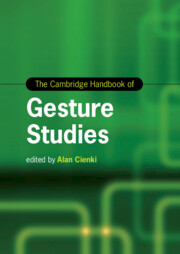Book contents
- The Cambridge Handbook of Gesture Studies
- Cambridge Handbooks in Language and Linguistics
- The Cambridge Handbook of Gesture Studies
- Copyright page
- Contents
- Figures
- Tables
- Contributors
- Introduction
- Part I Gestural Types: Forms and Functions
- Part II Ways of Approaching Gesture Analysis
- Part III Gestures and Language
- 13 The Role of Gesture in Debates on the Origins of Language
- 14 Gesture and First Language Development: The Multimodal Child
- 15 Gesture and Second/Foreign Language Acquisition
- 16 Gesture and Sign Language
- 17 On Grammar–Gesture Relations: Gestures Associated with Negation
- Part IV Gestures in Relation to Cognition
- Part V Gestures in Relation to Interaction
- Index
- References
14 - Gesture and First Language Development: The Multimodal Child
from Part III - Gestures and Language
Published online by Cambridge University Press: 01 May 2024
- The Cambridge Handbook of Gesture Studies
- Cambridge Handbooks in Language and Linguistics
- The Cambridge Handbook of Gesture Studies
- Copyright page
- Contents
- Figures
- Tables
- Contributors
- Introduction
- Part I Gestural Types: Forms and Functions
- Part II Ways of Approaching Gesture Analysis
- Part III Gestures and Language
- 13 The Role of Gesture in Debates on the Origins of Language
- 14 Gesture and First Language Development: The Multimodal Child
- 15 Gesture and Second/Foreign Language Acquisition
- 16 Gesture and Sign Language
- 17 On Grammar–Gesture Relations: Gestures Associated with Negation
- Part IV Gestures in Relation to Cognition
- Part V Gestures in Relation to Interaction
- Index
- References
Summary
This chapter presents the role and use of gesture in first language development and its integration in the child’s multimodal communicative system. It includes an overview of theories and methods that have triggered and facilitated the study of gestures in language development. The main issues are illustrated with detailed analyses of examples extracted from longitudinal data in English and French. The human communication system develops in a space of shared meanings in which adults socialize children into language in situated activities; consequently, this overview highlights the crucial role of caregivers in child–adult interactions. We first focus on the role of gestures in adults’ communicative input and then follow children’s development into the use of the adults’ multimodal communicative system. At the end of the developmental process, speech becomes clearly predominant but is both complemented and supplemented by other semiotic resources according to variables such as linguistic context, situation, interlocutor, activity, or discourse genre. Children learn to master the dynamic multimodal communicative system used around them and with them in their daily interactions.
Keywords
- Type
- Chapter
- Information
- The Cambridge Handbook of Gesture Studies , pp. 368 - 397Publisher: Cambridge University PressPrint publication year: 2024
References
- 2
- Cited by

